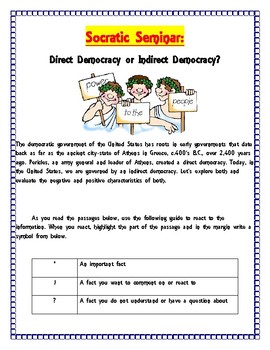Comparing Ancient Athenian Greek and American Democracy (Socratic Seminar)
- PDF
What educators are saying
Also included in
- Conduct Socratic Seminars in your middle school ancient civilization classroom!This bundle includes:-A powerpoint with both teacher guidance and class presentation slides on how to easily run an effective Socratic Seminar. Assessment rubric is included!-5 Lesson Plans 1. Hammurabi's Code- Have yoPrice $11.00Original Price $16.25Save $5.25
Description
Whether teaching about ancient Greece or U.S. Democracy, this activity gives students the opportunity to compare the similarities between direct and indirect democracies. Guided questions challenge students to respond to information by applying new concepts and evaluating both forms of democracy.
Holding a Socratic Seminar discussion with this activity will encourage students to explore beyond the text and questions.
This activity includes:
-a document for reading and comparing Athenian Democracy to the Democracy in the United States
-guided questions for understanding the content, forming comparison, as well as fostering critical thinking skills such as application and evaluation.
-content to conduct a Socratic Seminar
-21st Century Skills: reading, critical thinking, and collaboration





